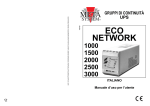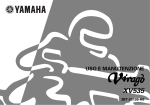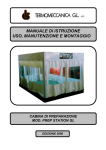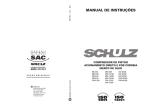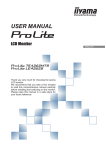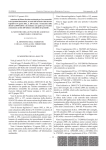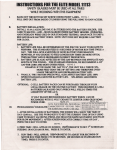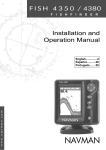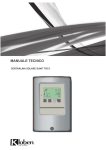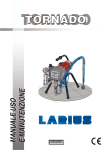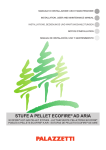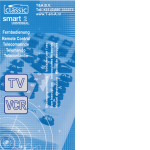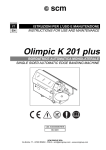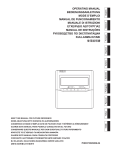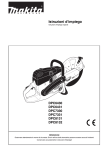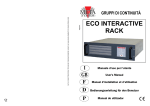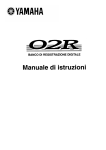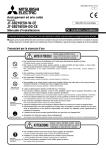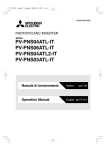Download Bruciatori di nafta Heavy oil burners
Transcript
Istruzioni per installazione, uso e manutenzione Installation, use and maintenance instructions I GB Bruciatori di nafta Heavy oil burners Funzionamento bistadio Two stage operation CODICE - CODE MODELLO - MODEL TIPO - TYPE 3433200 RN 28 633 T1 3433300 RN 38 634 T1 3433400 RN 50 635 T1 3891500 Bag 40 3891501 Bag 50 2915585 4-98 I GB INDICE DATI TECNICI . . . . . . . . . . . . . . . . . . . . . . . . . . . . . . . . . pagina Imballo . . . . . . . . . . . . . . . . . . . . . . . . . . . . . . . . . . . . . . . . . . . . . Ingombro . . . . . . . . . . . . . . . . . . . . . . . . . . . . . . . . . . . . . . . . . . . Descrizione bruciatore . . . . . . . . . . . . . . . . . . . . . . . . . . . . . . . . . Descrizione BAG . . . . . . . . . . . . . . . . . . . . . . . . . . . . . . . . . . . . . Materiale a corredo . . . . . . . . . . . . . . . . . . . . . . . . . . . . . . . . . . . Campi di lavoro. . . . . . . . . . . . . . . . . . . . . . . . . . . . . . . . . . . . . . . 3 4 4 4 5 5 6 CONTENTS TECHNICAL DATA . . . . . . . . . . . . . . . . . . . . . . . . . . . . . . pagina Packaging . . . . . . . . . . . . . . . . . . . . . . . . . . . . . . . . . . . . . . . . . . . Max. dimensions . . . . . . . . . . . . . . . . . . . . . . . . . . . . . . . . . . . . . . Burner description. . . . . . . . . . . . . . . . . . . . . . . . . . . . . . . . . . . . . BAG description . . . . . . . . . . . . . . . . . . . . . . . . . . . . . . . . . . . . . . Standard equipment . . . . . . . . . . . . . . . . . . . . . . . . . . . . . . . . . . . Working Þelds . . . . . . . . . . . . . . . . . . . . . . . . . . . . . . . . . . . . . . . . 3 4 4 4 5 5 6 INSTALLAZIONE . . . . . . . . . . . . . . . . . . . . . . . . . . . . . . . . . . . . . 7 Piastra caldaia . . . . . . . . . . . . . . . . . . . . . . . . . . . . . . . . . . . . . . . 7 Lunghezza boccaglio . . . . . . . . . . . . . . . . . . . . . . . . . . . . . . . . . . 7 Fissaggio del bruciatore alla caldaia . . . . . . . . . . . . . . . . . . . . . . 7 Scelta degli ugelli per il 1° e 2° stadio . . . . . . . . . . . . . . . . . . . . . 7 Montaggio degli ugelli. . . . . . . . . . . . . . . . . . . . . . . . . . . . . . . . . . 7 Regolazione testa di combustione . . . . . . . . . . . . . . . . . . . . . . . . 8 Impianto idraulico . . . . . . . . . . . . . . . . . . . . . . . . . . . . . . . . . . . . . 8 Alimentazione combustibile . . . . . . . . . . . . . . . . . . . . . . . . . . . . . 8 Collegamenti idraulici . . . . . . . . . . . . . . . . . . . . . . . . . . . . . . . . . 10 BAG a sinistra del bruciatore . . . . . . . . . . . . . . . . . . . . . . . . . . . 10 Impianti elettrici . . . . . . . . . . . . . . . . . . . . . . . . . . . . . . . . . . . . . 11 Pompa . . . . . . . . . . . . . . . . . . . . . . . . . . . . . . . . . . . . . . . . . . . . 16 Innesco pompa. . . . . . . . . . . . . . . . . . . . . . . . . . . . . . . . . . . . . . 16 Temperatura di polverizzazione . . . . . . . . . . . . . . . . . . . . . . . . . 16 Termoregolatore . . . . . . . . . . . . . . . . . . . . . . . . . . . . . . . . . . . . . 17 Regolazione servomotore . . . . . . . . . . . . . . . . . . . . . . . . . . . . . 18 Accensione bruciatore . . . . . . . . . . . . . . . . . . . . . . . . . . . . . . . . 18 Funzionamento bruciatore . . . . . . . . . . . . . . . . . . . . . . . . . . . . . 19 Led Panel . . . . . . . . . . . . . . . . . . . . . . . . . . . . . . . . . . . . . . . . . . 19 VeriÞche e manutenzione . . . . . . . . . . . . . . . . . . . . . . . . . . . . . . 20 Funzionamento con olii ecologici . . . . . . . . . . . . . . . . . . . . . . . . 21 Kit precircolazione olii densi . . . . . . . . . . . . . . . . . . . . . . . . . . . . 21 Manutenzione gruppo valvole. . . . . . . . . . . . . . . . . . . . . . . . . . . 21 INSTALLATION . . . . . . . . . . . . . . . . . . . . . . . . . . . . . . . . . . . . . . 7 Boiler plate . . . . . . . . . . . . . . . . . . . . . . . . . . . . . . . . . . . . . . . . . . 7 Blast tube length . . . . . . . . . . . . . . . . . . . . . . . . . . . . . . . . . . . . . . 7 Securing the burner to the boiler. . . . . . . . . . . . . . . . . . . . . . . . . . 7 Choice of nozzles for 1st and 2nd stage . . . . . . . . . . . . . . . . . . . . 7 Nozzle assembly . . . . . . . . . . . . . . . . . . . . . . . . . . . . . . . . . . . . . . 7 Combustion head setting . . . . . . . . . . . . . . . . . . . . . . . . . . . . . . . 8 Hydraulic system. . . . . . . . . . . . . . . . . . . . . . . . . . . . . . . . . . . . . . 8 Fuel supply . . . . . . . . . . . . . . . . . . . . . . . . . . . . . . . . . . . . . . . . . . 8 Hydraulic connections . . . . . . . . . . . . . . . . . . . . . . . . . . . . . . . . . 10 BAG on left of burner . . . . . . . . . . . . . . . . . . . . . . . . . . . . . . . . . 10 Electrical systems . . . . . . . . . . . . . . . . . . . . . . . . . . . . . . . . . . . . 11 Pump. . . . . . . . . . . . . . . . . . . . . . . . . . . . . . . . . . . . . . . . . . . . . . 16 Pump priming . . . . . . . . . . . . . . . . . . . . . . . . . . . . . . . . . . . . . . . 16 Spray temperature . . . . . . . . . . . . . . . . . . . . . . . . . . . . . . . . . . . 16 Temperature controller . . . . . . . . . . . . . . . . . . . . . . . . . . . . . . . . 17 Servomotor adjustment . . . . . . . . . . . . . . . . . . . . . . . . . . . . . . . . 18 Burner ignition. . . . . . . . . . . . . . . . . . . . . . . . . . . . . . . . . . . . . . . 18 Burner operation . . . . . . . . . . . . . . . . . . . . . . . . . . . . . . . . . . . . . 19 Led Panel . . . . . . . . . . . . . . . . . . . . . . . . . . . . . . . . . . . . . . . . . . 19 Checks and maintenance . . . . . . . . . . . . . . . . . . . . . . . . . . . . . . 20 Operation with ecological oils . . . . . . . . . . . . . . . . . . . . . . . . . . . 21 Heavy oil pre-circulation kit . . . . . . . . . . . . . . . . . . . . . . . . . . . . . 21 Maintenance of valve unit . . . . . . . . . . . . . . . . . . . . . . . . . . . . . 21 Inconvenienti - Cause. . . . . . . . . . . . . . . . . . . . . . . . . . . . . . . . . 22 Troubleshooting (Fault - Causes) . . . . . . . . . . . . . . . . . . . . . . . . 23 NOTA. In conformitˆ con la Direttiva Rendimento 92/42/CEE, lÕapplicazione del bruciatore alla caldaia, la regolazione e il collaudo, devono essere eseguiti nellÕosservanza del manuale dÕistruzione della caldaia stessa, compreso il controllo della concentrazione di CO e CO2 nei fumi, della loro temperatura e di quella media dellÕacqua della caldaia. NOTE. In conformity with EfÞciency Directive 92/42/EEC the application of the burner on the boiler, adjustment and testing must be carried out observing the instruction manual of the boiler, including veriÞcation of the CO and CO2 concentration in the ßue gases, their temperatures and the average temperature of the water in the boiler. 2 DATI TECNICI I MODELLO TIPO POTENZA (1) PORTATA (1) RN 28 stadio 2° stadio 1° kW kg/h kW kg/h COMBUSTIBILE FUNZIONAMENTO IMPIEGO STANDARD TEMPERATURA ARIA COMBURENTE ALIMENTAZIONE ELETTRICA °C max V Hz rpm W V A rpm W V A W W max MOTORE ELETTRICO VENTILATORE MOTORE ELETTRICO POMPA RISCALDATORI POTENZA ELETTRICA ASSORBITA GRADO DI PROTEZIONE CONFORMITË DIRETTIVE CEE RUMOROSITË (2) (1) (2) dBA RN 38 633 T1 634 T1 228 - 342 273 - 456 20 - 30 24 - 40 114 - 228 136 - 273 12 - 24 10 - 20 OLIO, viscositˆ max. a 50 °C: 150 cSt - 20 °E ¥ Intermittente (min. 1 arresto in 24 ore). ¥ Bistadio (alta e bassa Þamma). Caldaie: ad acqua, a vapore, ad olio diatermico 60 230 - 400 con neutro ~ +/-10% 50 - trifase 2800 2800 250 450 220 - 240 220/240 - 380/415 2,1 2 - 1,2 1400 250 220/240 - 380/415 1,55 0,9 2800 4200 3800 5100 IP 44 89/336 - 73/23 - 89/392 - 92/42 68,0 70,0 RN 50 635 T1 342 - 570 30 - 50 171 - 342 15 - 30 2800 650 220/240 - 380/415 3,0 - 1,7 4200 5500 75,0 Condizioni di riferimento: Temperatura ambiente 20°C - Pressione barometrica 1000 mbar - Altitudine 100 m s.l.m. Pressione sonora misurata in laboratorio combustione dal costruttore, con bruciatore funzionante su caldaia di prova, alla potenza massima. TECHNICAL DATA GB MODEL TYPE OUTPUT (1) DELIVERY (1) RN 28 2nd stage 1st stage kW kg/h kW kg/h FUEL OPERATION STANDARD APPLICATIONS COMBUSTION AIR TEMPERATURE ELECTRICAL SUPPLY FAN ELECTRIC MOTOR PUMP ELECTRIC MOTOR HEATERS ELECTRICAL CONSUMPTION ELECTRICAL PROTECTION CONFORMITY TO EEC DIRECTIVES NOISE LEVELS (2) (1) (2) °C max V Hz rpm W V A rpm W V A W W max dBA RN 38 633 T1 634 T1 228 - 342 273 - 456 20 - 30 24 - 40 114 - 228 136 - 273 12 - 24 10 - 20 OIL, viscosity max. at 50 °C: 150 cSt - 20 °E ¥ Intermittent (min. 1 stop in 24 hours). ¥ Two-stage (high and low ßame). Boilers: water, steam, diathermic oil 60 230 - 400 with neutral ~ +/-10% 50 - three-phase 2800 2800 250 450 220 - 240 220/240 - 380/415 2.1 2 - 1.2 1400 250 220/240 - 380/415 1.55 0.9 2800 4200 3800 5100 IP 44 89/336 - 73/23 - 89/392 - 92/42 68.0 70.0 Reference conditions: Ambient temperature 20°C - Barometer pressure 1000 mbar - Altitude 100 m a.s.l. Acoustic pressure measured in manufacturerÕs laboratory, with burner operating on test boiler at maximum output. 3 RN 50 635 T1 342 - 570 30 - 50 171 - 342 15 - 30 2800 650 220/240 - 380/415 3.0 - 1.7 4200 5500 75.0 IMBALLO - PACKAGING INGOMBRO - MAX. DIMENSIONS RN 28 - 38 - 50 Fig. 1 mm Bag Fig. 2 A B C kg mm A B C D E F G H RN 28 - 38 - 50 1015 630 500 RN 28 - 38 - 50 476 474 468 265 166 352 52 730 Bag 40 - 50 824 859 394 Bag 40 - 50 680 763 780 276 324 650 - - DESCRIZIONE BRUCIATORE (Fig. 3) BURNER DESCRIPTION (Fig. 3) 1 2 3 4 5 - 1 2 3 4 5 - 6 7 - 6 7 - 8 9 10 11 12 - 8 9 10 11 12 - 13 14 15 - 16 17 18 - Testa di combustione Vite per regolazione testa di combustione Fotoresistenza per il controllo presenza Þamma Vite per il Þssaggio ventilatore alla ßangia Guide per apertura bruciatore ed ispezione alla testa di combustione Servomotore serranda aria Piastrina predisposta per ottenere 4 fori, utili al passaggio dei cavi elettrici. Presa di pressione ventilatore Flangia per il Þssaggio alla caldaia Visore Þamma LED PANEL Contattore motore e rel• termico con pulsante di sblocco (RN 38 - RN 50) Condensatore motore (RN 28) Apparecchiatura elettrica con spia di blocco e pulsante di sblocco Due interruttori elettrici: - uno per Òacceso-spento bruciatoreÓ; - uno per Ò1° - 2° stadioÓ. Prolunghe per guide 5) Spine per il collegamento elettrico Collettore 13 14 15 - 16 17 18 - Fig. 3 4 Combustion head Screw for combustion head adjustment Photocell for ßame presence control Screw for Þxing fan to ßange Slide bars for opening the burner and inspecting the combustion head Air damper servomotor Plate designed to accept 4 drilled holes for routing electrical cables. Fan pressure test point Boiler mounting ßange Flame inspection window LED PANEL Motor contactor and thermal cut-out with reset button (RN 38 - RN 50) Motor capacitor (RN 28) Control box with lock-out light and reset button Two switches: - Òburner off - onÓ - Ò1st - 2nd stage operationÓ. Extensions for slide bars 5) Plugs for electrical connections Manifold Fig. 4 DESCRIZIONE BAG (Fig. 4) BAG DESCRIPTION (Fig. 4) 1 2 3 1 2 3 4 5 6 7 8 9 10 11 12 13 14 15 16 17 18 19 20 21 22 23 24 25 26 27 28 29 30 31 32 - Manometro pressione anello di alimentazione - Manometro pressione polverizzazione - Resistenze autoregolanti di preriscaldo Þltro in aspirazione, Þltro in mandata, valvola e pompa - Termostato di max. - Termostato di min. - Termostato di max. con pulsante di riarmo - Pressostato controllo pressione anello con consenso funzionamento bruciatore (tarato a 1 bar) - Motore pompa - Vite regolazione pressione pompa - Pompa - Attacco pressione pompa (1/8Ó) - Valvola normalmente aperta di prelavaggio - Regolatore pressione anello - Degasatore - Valvola di scarico gas da degasatore, da tarare in funzione della quantitˆ di gas in formazione sul degasatore (generalmente 1/4 giro • sufÞciente) - Filtro a pettine in mandata - Morsettiera - Passacavi - Presa di collegamento elettrico bag/bruciatore - Contattore comando resistenze serbatoio - Contattore con rel• termico comando motore pompa - Termostato elettronico - Trasformatore alimentazione termostato elettronico - Termoresistenza Pt 100 - Ritorno dal bruciatore - Mandata al bruciatore - Valvola antigas - Filtro a pettine in aspirazione pompa - Mandata da anello di alimentazione (1Ó) - Ritorno anello di alimentazione (3/4Ó) - Serbatoio preriscaldatore - Regolazione pressione prelavaggio (tarata in fabbrica a circa 10 bar) MATERIALE A CORREDO 4 5 6 7 8 9 10 11 12 13 14 15 16 17 18 19 20 21 22 23 24 25 26 27 28 29 30 31 32 - Pressure gauge for fuel supply loop - Atomising pressure gauge - Self-controlling resistances for warming suction Þlter, delivery Þlter, valve and pump - High point thermostat - Low point thermostat - High point thermostat with reset push-button - Loop pressure control switch with burner operation enable (set at 1 bar) - Pump motor - Pump pressure adjustment screw - Pump - Pump pressure join (1/8Ó) - Normally open pre-purge valve - Loop pressure regulator - Degassing unit - Valve for gas release from degassing unit. Set according to gas quantity in degassing unit (1/4 turn is usually sufÞcient) - Comb-Þlter at delivery - Terminal strip - Fairleads - Bag/burner electrical connection socket - Contactor commanding tank heating elements - Contactor with thermal relay commanding pump motor - Electronic thermostat - Transformer powering electronic thermostat - Heating element Pt100 - Return from burner - Delivery to burner - Back pressure valve - Comb-Þlter at pump suction - Inlet from fuel supply loop (1Ó) - Return to fuel supply loop (3/4Ó) - Pre-heater - Pre-purge pressure adjustment (factory set at about 10 bar) N° Tubi ßessibili per collegamento bruciatore/bag 2 STANDARD EQUIPMENT N° Hoses for burner/bag connection 2 Isolante per tubi ßessibili 1 Insulation for hoses 1 Schermo termico 1 Thermal insulation screen 1 4 Viti per Þssare la ßangia del bruciatore alla caldaia: M8 x 25 4 Screws to secure the burner ßange to the boiler: M8 x 25 Passacavi per collegamento elettrico (RN 28) 3 Fairleads for electrical connections (RN 28) 3 Passacavi per collegamento elettrico (RN 38 - RN 50) 4 Fairleads for electrical connections (RN 38 - RN 50) 4 Tubo per applicazione BAG sulla sinistra 1 Tube for installing BAG on left 1 Ugelli 2 Nozzles 2 Istruzione 1 Instruction boohlet 1 Catalogo ricambi 1 Spare parts list 1 5 pressione cam. comb. mbar comb. chamb. pressure mbar Fig. 5 CAMPI DI LAVORO (Fig. 5) WORKING FIELDS (Fig. 5) ¥ La PORTATA del 1° stadio non deve scendere sotto i valori minimi ¥ 1st stage DELIVERY must not fall below minimum values of the working Þeld. del campo di lavoro. ¥ La PORTATA del 2° stadio va scelta entro lÕarea A. ¥ 2nd stage DELIVERY must be selected in area A. Il punto di lavoro si trova tracciando una verticale dalla portata desiderata ed una orizzontale dalla pressione corrispondente in camera di combustione. Attenzione: il CAMPO DI LAVORO • stato ricavato alla temperatura ambiente di 20 °C, alla pressione barometrica di 1000 mbar (circa 100 m s.l.m.) e con la testa di combustione regolata come indicato a pag. 8. The work point may be found by plotting a vertical line from the desired delivery and a horizontal line from the corresponding pressure in the combustion chamber. Attention: WORKING FIELDS were obtained at ambient temperature of 20°C, and an atmospheric pressure of 1000 mbar (approx. 100 m above sea level) and with the combustion head adjusted as shown on page 8. Con olii densi, per ridurre lo sporcamento della caldaia, si consiglia un funzionamento prevalente in 2° stadio, perch• in 1° stadio: - la temperatura dellÕolio allÕugello • pi• bassa rispetto al 2° stadio per minor combustibile in attraversamento (vedi pag. 26); - lÕugello di primo stadio • decentrato; - la pressione dellÕaria alla testa di combustione • bassa con scarsa miscelazione aria/combustibile. To reduce fouling the combustion head and boiler when using dense oils, we suggest mainly 2nd stage operation, because with the 1st stage: - oil temperature on the nozzle is lower compared to that at the 2nd stage due to reduced fuel ßow (see page 26); - 1st stage nozzle is off centre; - air pressure on the combustion head is lower with improper mixing between air and fuel. Fig. 6 mm RN 28 - 38 - 50 A B C 170 224 M 8 Fig. 7 6 INSTALLAZIONE INSTALLATION PIASTRA CALDAIA (Fig. 6) BOILER PLATE (Fig. 6) Forare la piastra di chiusura della camera di combustione come in Fig. 6. La posizione dei fori Þlettati pu˜ essere tracciata utilizzando lo schermo termico a corredo del bruciatore. Drill the combustion chamber locking plate as shown in Fig. 6. The position of the threaded holes can be marked using the thermal screen supplied with the burner. LUNGHEZZA BOCCAGLIO (Fig. 7) BLAST TUBE LENGTH (Fig. 7) Per le caldaie con giro dei fumi anteriore 10), o con camera ad inversione di Þamma, eseguire una protezione in materiale refrattario 8), tra refrattario caldaia 9) e boccaglio 7). La protezione deve consentire al boccaglio di essere estratto. Per le caldaie con il frontale raffreddato ad acqua non • necessario il rivestimento refrattario 8)-9), se non vi • espressa richiesta del costruttore della caldaia. The length L of the blast tube must be selected according to the indications provided by the manufacturer of the boiler, and in any case it must be greater than the thickness of the boiler door complete with its fettling. For boilers with front ßue passes 10) or ßame inversion chambers, protective fettling in refractory material 8) must be inserted between the boiler fettling 9) and the blast tube 7). This protective fettling must not compromise the extraction of the blast tube. For boilers having a water-cooled front the refractory fettling 8)-9) is not required unless it is expressly requested by the boiler manufacturer. FISSAGGIO DEL BRUCIATORE ALLA CALDAIA (Fig. 7) SECURING THE BURNER TO THE BOILER (Fig. 7) La lunghezza L del boccaglio va scelta secondo le indicazioni del costruttore della caldaia e, in ogni caso, deve essere maggiore dello spessore della porta della caldaia, completa di refrattario. Separate the front from the rear section as shown in Fig. 7. - Remove the screws 2) from the two slide bars 3). - Remove the screw 1) Þxing the burner 4) to the ßange 5). - Withdraw the blast tube 7) complete with ßange 5) and slide bars 3). Secure ßange 5) to the boiler plate interposing the supplied gasket 6). Use the 4 screws provided after having protected the thread with antiscrufÞng products (high temperature grease, compounds, graphite). The burner-boiler seal must be airtight. Separare la parte anteriore dalla parte posteriore come illustrato in Fig. 7. - Togliere le viti 2) dalle due guide 3). - Togliere la vite 1) che Þssa il bruciatore 4) alla ßangia 5). - SÞlare il boccaglio 7) completo di ßangia 5) e guide 3). Fissare la ßangia 5) alla piastra della caldaia interponendo la guarnizione 6) data a corredo ed utilizzando le 4 viti pure date a corredo dopo averne protetto la Þlettatura con prodotti antigrippanti (grasso per alte temperature, compounds, graÞte). La tenuta bruciatore-caldaia deve essere ermetica. CHOICE OF NOZZLES FOR 1ST AND 2ND STAGE Both nozzles must be chosen from among those listed in Table of Fig. 8. The Þrst nozzle determines the delivery of the burner in the 1st stage. The second nozzle works together with the 1st nozzle to determine the delivery of the burner in the 2nd stage. SCELTA DEGLI UGELLI PER 1° E 2° STADIO Entrambi gli ugelli vanno scelti tra quelli indicati nella tabella di Fig. 8. Il primo ugello determina la portata del bruciatore in 1° stadio. Il secondo ugello funziona assieme al primo ed entrambi determinano la portata del bruciatore in 2° stadio. 45° kg/h (1) 20 bar 23 bar 25 bar 10,4 12,0 13,5 15,0 18,0 21,0 24,0 26,9 11,3 12,9 14,5 16,0 19,3 22,5 25,8 29,0 11,8 13,5 15,2 16,9 20,2 23,6 27,0 30,3 GPH 1,75 2,00 2,25 2,50 3,00 3,50 4,00 4,50 (1) olio/oil: densitˆ/density 0,94 kg/dm3 viscositˆ/viscosity 7 cSt/110 °C Fig. 8 Si consiglia lÕutilizzo di ugelli con angolo di polverizzazione di 45°; tuttavia il bruciatore funziona correttamente anche con ugelli con angolo di 60°. Generalmente i due ugelli sono di eguale portata. NOTA. I due ugelli dati a corredo possono essere utilizzati quando corrispondono alla portata richiesta. In caso contrario vanno sostituiti con altri due di portata adatta all'impianto. We advise you to use nozzles with a 45° spray angle; however, the burner will operate correctly also with 60° nozzles. The two nozzles usually have equal deliveries. NOTE. The two supplied nozzles may be used when they correspond to the required delivery, otherwise they are to be replaced by others with a delivery suitable to the system. MONTAGGIO DEGLI UGELLI (Fig. 8) When the burner is still disassembled from the blast tube, Þt the nozzle with the box spanner 1) (da 16 mm), after having removed the plastic plugs 2), Þtting the spanner through the central hole in the ßame stability disk 5). Do not use any sealing products such as gaskets, sealing compound, or tape. Be careful to avoid damaging the nozzle sealing seat. The nozzles must be screwed into place tightly but not to the maximum torque value provided by the wrench. The nozzle for the 1st stage of operation is the one lying beneath the electrodes, Fig. 9. Make sure that the electrodes are positioned as shown in Þg. 9. Finally remount the burner 4)(Fig. 7) on the slide bars 3) and slide it up to the ßange 5), keeping it slightly raised to prevent the ßame stability disk from pressing against the blast tube. Tighten the screws 2) on the slide bars 3) and screw 1) that attaches the burner to the ßange. If it proves necessary to change a nozzle with the burner already Þtted to the boiler, proceed as outlined below: - install the extensions; - back off screws 3) and remove disk 5); - use spanner 4) to change the nozzles. NOZZLE ASSEMBLY (Fig. 8) Con il bruciatore separato dal boccaglio montare i due ugelli con la chiave a tubo 1) (da 16 mm), dopo aver tolto i tappi in plastica 2), passando dall'apertura centrale del disco di stabilitˆ Þamma 5). Non usare prodotti per la tenuta: guarnizioni, nastro o sigillanti. Fare attenzione di non ammaccare o incidere la sede di tenuta dell'ugello. Il serraggio dell'ugello deve essere energico ma senza raggiungere lo sforzo massimo consentito dalla chiave. L'ugello di 1° stadio • quello sotto gli elettrodi d'accensione, Þg. 9. Controllare che gli elettrodi siano posizionati come in Fig. 9. Rimontare, inÞne, il bruciatore 4)(Fig. 7) sulle guide 3) e farlo scorrere Þno alla ßangia 5), tenendolo leggermente sollevato per evitare che il disco di stabilitˆ Þamma entri in contrasto con il boccaglio. Avvitare le viti 2) sulle guide 3) e la vite 1) che Þssa il bruciatore alla ßangia. Per sostituire un ugello con bruciatore giˆ applicato alla caldaia, procedere come segue: - montare le prolunghe; - allentare le viti 3) e togliere il disco 5); Fig. 9 - sostituire l'ugello con la chiave 4). 7 N° Tacche / Notches Portata in 2° stadio kg/h Delivery at 2nd stage kg/h Fig. 10 Fig. 11 REGOLAZIONE TESTA DI COMBUSTIONE COMBUSTION HEAD SETTING La regolazione della testa di combustione dipende unicamente dalla portata del bruciatore in 2° stadio, cio• dalla portata dei due ugelli scelti a pag. 7. Ruotare la vite 4)(Fig. 10) Þno a far collimare la tacca indicata nel diagramma (Fig. 11) con il piano anteriore della ßangia 5)(Fig. 10). The setting of the combustion head depends exclusively on the delivery of the burner in the 2nd stage - in other words, the combined delivery of the two nozzles selected on page 7. Turn screw 4)(Fig. 10) until the notch shown in diagram (Fig. 11) is level with the front surface of ßange 5)(Fig. 10). IMPIANTO IDRAULICO HYDRAULIC SYSTEM A cura dellÕinstallatore The responsibility of the installer Di serie su bruciatore e Bag Standard for burner and Bag Fig. 12 ALIMENTAZIONE COMBUSTIBILE (Fig. 12) FUEL SUPPLY (Fig. 12) ¥ Impianto ad anello (impianto raccomandato) Il circuito ad anello • costituito da un condotto che parte e torna in cisterna nel quale una pompa ausiliaria fa scorrere il combustibile sotto pressione. Se la pompa • troppo grande prevedere un by-pass regolabile [il regolatore di pressione 13)(Fig. 4) potrebbe non ridurre sufÞcientemente la pressione e danneggiare lÕorgano di tenuta della pompa]. ¥ The loop circuit (recommended system) A loop circuit consists of a loop of piping departing from and returning to the tank with an auxiliary pump that circulates the fuel under pressure. If the pump is too large, install and adjustable by-pass. The pressure governor 13)(Fig.4) may not reduce pressure sufÞciently and could damage the pump seal. 8 LEGENDA (Fig. 12) C - Cisterna (con pescante preriscaldato per viscositˆ > 7°E/50°C) FA - Filtro anello 500 m (preriscaldato per viscositˆ > 7°E/50°C) FD - Degasatore con Þltro autopulente da 300 m FM - Filtro mandata autopulente da 100 m MA - Manometro pressione anello di alimentazione MM - Manometro pressione polverizzazione P - Pompa alta pressione alimentazione bruciatore PA - Pompa anello con by-pass (portata doppia rispetto alla potenza installata) PO - Pressostato di consenso pressione anello PR - Preriscaldatore olio RS - Resistenza di mantenimento S - Saracinesche di esclusione U1 - Ugello 1° stadio U2 - Ugello 2° stadio V - Valvola manuale di sÞato degasatore VA - Valvola antigas VS - Regolatore di pressione (taratura di fabbrica: 1,5 bar) VP - Valvola (NA) di prelavaggio V1 - Valvola 1° stadio V2 - Valvola 2° stadio VR - Valvola manuale regolazione pressione prelavaggio KEY TO LAYOUT (Fig. 12) C - Tank (with preheated suction device for viscosity > 7°E/50°C) FA - Loop Þlter 500 m (pre-heated for viscosity > 7°E/50°C) FD - Degassing unit with 300 m self-cleaning Þlter FM - Self-cleaning 100 m delivery Þlter MA - Fuel supply loop pressure gauge MM - Atomisation pressure gauge P - High pressure pump supplying fuel to burner PA - Loop pump with by-pass (ßow rate double compared to rated output) PO - Loop pressure enable pressure switch PR - Oil pre-heater RS - Maintaining heating element S - Shut-off gate U1 - 1st stage nozzle U2 - 2nd stage nozzle V - Degassing unit breather valve (manual) VA - Back pressure valve VS - Pressure regulator (factory setting: 1.5 bar) VP - Norm.open pre-purge valve (NO) V1 - 1st stage valve V2 - 2nd stage valve VR - Pre-purge pressure adjustment valve (manual) La pressione dellÕanello deve essere maggiore di 1 bar e non deve superare 4 bar. Il pressostato 7)(Fig. 4) • tarato in fabbrica ad 1 bar (taratura di consenso al funzionamento); per variare questa taratura togliere il tappo sopra il pressostato ed agire sulla vite sottostante (svitando si diminuisce, avvitando si aumenta). Il pressostato • installato in aspirazione della pompa, quindi, oltre a controllare la pressione dellÕanello, veriÞca anche lÕintasamento del Þltro in aspirazione. Se il Þltro • intasato, la pressione dellÕanello darebbe inizialmente il consenso, alla partenza della pompa si formerebbe una depressione che toglierebbe il consenso, il bruciatore continuerebbe in questo modo Þno alla pulizia del Þltro. Se la semplice rotazione della manopola 28)(Fig. 4) non • sufÞciente bisogna pulire il pacco Þltrante; se tutto • in ordine e si manifesta lÕinconveniente, bisogna aumentare la pressione dellÕanello: se ci˜ non • possibile bisogna diminuire la regolazione di intervento del pressostato 7)(Fig. 4). Loop pressure must be over 1 bar and not exceed 4 bar. The pressure switch 7)(Fig.4) is factor set to 1 bar (setting enabling operation). To modify this setting, remove the plug on top of the pressure switch and turn the screw underneath (anti-clockwise to reduce, clockwise to increase). The pressure switch is installed at the pump suction intake. Therefore, in addition to controlling loop pressure, it also checks the condition (degree of obstruction) of the suction Þlter. If the Þlter is clogged, the pressure of the loop initially enables operation. However, in this case, when the pump starts, a vacuum is created that disables operation, and the burner continues reacting in this way until the Þlter is cleaned. If turning the handle 28)(Fig.4) is insufÞcient, the Þlter unit must be cleaned. If everything is in order, but the trouble continues, loop pressure must be increased. If this is not possible, the pressure switch 7)(Fig.4) tripping point must be reduced. Note ¥ Eseguire le tubazioni dellÕanello con tubo ³ DN 25; per olio > 7°E/ 50°C devono essere opportunamente coibentate e riscaldate. ¥ La pressione dellÕanello deve essere regolata in funzione della temperatura e del tipo di olio; orientativamente 2 bar per olio con viscositˆ Þno a 100 cSt, 3 bar per viscositˆ maggiori. Notes ¥ For the loop tubing, use ³ DN 25 tube. For > 7°E/50°C oil, the tubing must be appropriately insulated and heated. ¥ Loop pressure must be set according to the type of oil and its temperature Ð as a guide-line, 2 bar for oil with viscosity up to 100cSt, and 3 bar for higher viscosity levels. ¥ Impianto a caduta ¥ Drop system Utilizzabile solo per olii di bassa viscositˆ. é indispensabile che sia assicurata lÕalimentazione al bruciatore. Procedere come segue (riferimenti a Fig.4): - collegare il tubo di alimentazione allÕattacco 29); - collegare lÕattacco 30) con la parte superiore della cisterna: in questo caso allentare di 3 giri la valvola 15); se non si porta lÕattacco 30) in cisterna chiudere la valvola 15) ed aprirla periodicamente per scaricare eventuali formazioni di gas sul degasatore (eseguire questa operazione a bruciatore in sosta); - cortocircuitare il pressostato 7) (unire i due Þli sulla presa dello stesso): non darebbe il consenso per mancanza di pressione, sarebbe opportuno sostituirlo con un vacuometro (si ricorda che la pompa non pu˜ superare una depressione massima di 4 m (35 cm Hg). This system can only be used for low viscosity oils. Fuel supply to the burner must be assured. Procedure (references are to Fig.4): - connect the supply tube to the port 29); - connect port 30) to the upper section of the tank Ð in this case, back off valve 15) by three turns. If you do not connect port 30) to the tank, shut valve 15) and open it periodically to discharge any gas from the degassing unit (do this while the burner is idle); - short-circuiting pressure switch 7) (by connecting two wires on its socket) would not enable operation due to lack of pressure. We advise you to replace the switch with a vacuum gauge (remember that the pump cannot exceed a maximum vacuum value of 4 m (35 cm Hg). 9 Fig. 13 COLLEGAMENTI IDRAULICI (Fig. 13) HYDRAULIC CONNECTIONS (Fig. 13) Dopo aver collegato lÕanello di alimentazione collegare, mediante i tubi ßessibili dati a corredo, bruciatore e BAG (utilizzando nastro di teßon sul lato bruciatore), inserendo sugli stessi il tubo isolante dato a corredo; • impossibile invertire la mandata con il ritorno perch• si sono previste Þlettature differenti. I tubi di collegamento bag/bruciatore sono tubi speciali per alta pressione e alta temperatura; si consiglia la loro sostituzione almeno ogni due anni (con nafta densa e temperature maggiori di 140 °C si consiglia la sostituzione ogni anno). Essi possono essere sostituiti anche da tubazioni rigide; in tal caso • necessario proteggerle con materiale termoisolante. Le tubazioni rigide, inoltre, non permettono lÕapertura del bruciatore sulle guide; in caso di manutenzione del bruciatore si rende quindi necessario scollegarle. LÕunitˆ di pompaggio e preriscaldo (BAG) pu˜ essere messa pi• lontano di quanto consentito delle tubazioni ßessibili date a corredo; in tal caso realizzare delle prolunghe rigide sulla BAG e proteggerle con materiale termoisolante (si ricorda che per ogni metro di allungamento si ha una riduzione di temperatura allÕugello di circa 8°C, anche in caso di buon isolamento), aumentare di conseguenza la temperatura impostata sul termostato elettronico. Si sconsiglia di collocare la BAG ad una distanza dal bruciatore superiore ai 2 metri. After connecting the fuel supply loop, connect the burner and BAG, using the supplied hoses and applying Teßon tape on the burner side. Fit the supplied isolating tube on the hoses. The delivery and return ports cannot be inverted, as different threads are used. The burner-bag connection hoses are special tubes suitable for high pressure and temperature. We advise you to replace them at least every two years (if using dense heavy oil and operating at temperatures in excess of 140°C, replace every year). The hoses may be replaced by rigid tubes Ð in this case, protect them with heat insulation material. Furthermore, if rigid tubes are used, the burner cannot be opened on the guides, therefore the guides have to dismantled for burner maintenance. The pumping and pre-heating unit (BAG) may be located further than the supplied hoses would allow. To this end, Þt rigid extensions on the BAG and protect them with heat insulation material (remember that there is a temperature drop of about 8°C for every extra meter, even if insulation is efÞcient) and, as a result, increase the temperature setting on the electronic thermostat. You are recommended to locate the BAG not more than 2 meters away from the burner. Fig. 14 BAG A SINISTRA DEL BRUCIATORE (Fig. 14) BAG ON LEFT OF BURNER (Fig. 14) Il bruciatore • predisposto in fabbrica per BAG a destra, come illustrato in Fig. 13. Se si intende posizionare la BAG a sinistra del bruciatore, • necessario invertire il collettore e la posizione dei tubi posti nella testa di combustione. Procedere nel modo seguente: - svitare i due tubi dal collettore; - togliere il collettore svitando le due viti 5) e Þssarlo a sinistra del bruciatore, negli appositi fori posti sullo scudo anteriore; - togliere i tubi 1) e 2) dai relativi raccordi posti sotto la testa di combustione; - Þssare unÕestremitˆ del tubo 1) al collettore e lÕaltra estremitˆ al raccordo di Þssaggio del tubo 2); - Þssare unÕestremitˆ del tubo 3), dato a corredo, al collettore e lÕaltra estremitˆ al raccordo rimasto libero; - Þssare la piastrina di chiusura asole di passaggio tubi sul lato opposto del frontone 5)(Fig. 7). The burner is installed in the factory to accommodate the BAG on the right, as shown in Fig.13. If you wish to place the BAG on the left of the burner, reverse the manifold and the position of the tubes on the combustion head. Procedure: - unscrew the two tubes on the manifold; - remove the manifold by unscrewing the two screws 5) and securing it on the left of the burner, in the holes on the front guard; - remove the tubes 1) and 2) from the relevant unions located under the combustion head; - secure one end of the tube 1) to the manifold and the other end to the union securing tube 2); - secure one end of the supplied tube 3) to the manifold and the other end to the spare union; - secure the plate for closing the tube through-slots on the opposite side of the front section 5)(Fig. 7). 10 IMPIANTO ELETTRICO (eseguito in fabbrica) ELECTRICAL EQUIPMENT (factory made) I IMPIANTO ELETTRICO ESEGUITO RN 28 - BAG 40 Fig. 15 COLLEGAMENTO ELETTRICO (a cura dellÕinstallatore) ELECTRICAL CONNECTION (Þeld made) BAG 40 COLLEGAMENTO ELETTRICO (a cura dellÕinstallatore) ELECTRICAL CONNECTION (Þeld made) RN 28 Fig. 16 Fig. 17 11 IMPIANTO ELETTRICO (eseguito in fabbrica) ELECTRICAL EQUIPMENT (factory made) I IMPIANTO ELETTRICO ESEGUITO RN 38 - BAG 40 Fig. 18 COLLEGAMENTO ELETTRICO (a cura dellÕinstallatore) ELECTRICAL CONNECTION (Þeld made) BAG 40 COLLEGAMENTO ELETTRICO (a cura dellÕinstallatore) ELECTRICAL CONNECTION (Þeld made) RN 38 Fig. 19 Fig. 20 12 IMPIANTO ELETTRICO (eseguito in fabbrica) ELECTRICAL EQUIPMENT (factory made) I IMPIANTO ELETTRICO ESEGUITO RN 50 - BAG 50 Collegamento resistenze preriscaldatore Pre-heater resistances connections Fig. 21 COLLEGAMENTO ELETTRICO (a cura dellÕinstallatore) ELECTRICAL CONNECTION (Þeld made) BAG 50 COLLEGAMENTO ELETTRICO (a cura dellÕinstallatore) ELECTRICAL CONNECTION (Þeld made) RN 50 Fig. 23 230 V Fig. 22 13 400 V F A T10 T6 L mm2 2,5 2,5 IMPIANTO ELETTRICO ELECTRICAL SYSTEM LEGENDA (Fig. 15 - 16 - 17 - 18 - 19 - 20 - 21 - 22 - 23) C - Condensatore CMP - Contattore motore pompa CMV - Contattore motore ventilatore CR - Contattore resistenze RBO 522R - Apparecchiatura elettrica F - Soppressore FR - Fotoresistenza h1 - Contaore di 1° stadio h2 - Contaore di 2° stadio IN - Interruttore elettrico per arresto manuale bruciatore I1 - Interruttore: Òbruciatore acceso-spentoÓ I2 - Interruttore: Ò1° - 2° stadioÓ MR - Morsettiera resistenze MV - Motore ventilatore MP - Motore pompa MPR - Morsettiera preriscaldatore PO - Pressostato di consenso pressione anello PR - Serbatoio preriscaldatore - Resistenza preriscaldatore R1,2,3 KEY TO LAYOUTS (Fig. 15 - 16 - 17 - 18 - 19 - 20 - 21 - 22 - 23) C - Capacitor CMP - Pump motor contactor CMV - Fan motor contactor CR - Resistance contactor RBO 522R - Control box F - Damper FR - Photoresistance h1 - 1st stage hourcounter h2 - 2nd stage hourcounter IN - Manual burner stop switch I1 - Switch: Òburner on-offÓ I2 - Switch: Ò1st - 2nd stageÓ MR - Resistance terminal strip MV - Fan motor MP - Pump motor MPR - Pre-heater terminal strip PO - Loop pressure enable pressure switch PR - Pre-heater - Pre-heater resistance R1,2,3 RS1,2,3,4 - Resistenza di mantenimento RS1,2,3,4 - Maintaining heating element RT RT1 - Rel• termico motore ventilatore - Rel• termico motore pompa RT RT1 - Fan motor thermal cut-out - Pump motor thermal cut-out S SM SO T TA TB TE TL - S SM SO T TA TB TE TL - Tm TM TMR TP TR - Tm TM TMR TP TR - TS - X X4 X5 X7 XP XP4 XP5 XP7 U VP V1 V2 - TS X X4 X5 X7 XP XP4 XP5 XP7 U VP V1 V2 - Segnalazione di blocco a distanza Servomotore Sonda Pt 100 Trasformatore termoregolatore Trasformatore dÕaccensione Terra bruciatore Termoregolatore Telecomando di limite: ferma il bruciatore quando la temperatura o la pressione in caldaia supera il valore prestabilito Termostato a contatto di minima Termostato a contatto di massima Termostato a contatto di massima a riarmo manuale Terra preriscaldatore Telecomando di regolazione: comanda 1° e 2° stadio di funzionamento. Necessario solo nel funzionamento bistadio. Telecomando di sicurezza: interviene in caso di TL guasto. Spina di collegamento bruciatore/bag Spina a 4 poli Spina a 5 poli Spina a 7 poli Presa di collegamento bruciatore/bag Presa a 4 poli Presa a 5 poli Presa a 7 poli Led Panel Elettrovalvola di prelavaggio Elettrovalvola di 1° stadio Elettrovalvola di 2° stadio Remote lock-out signal Servomotor Sonde Pt 100 Temperature controller transformer Ignition transformer Burner ground (earth) connection Temperature controller Limit control device: this shuts down the burner when the boiler temperature or pressure exceeds the setpoint value. Minimum value contact thermostat Maximum value contact thermostat Maximum value contact thermostat with manual reset Pre-heater ground (earth) connection High-low mode control: this controls operating stages 1 and 2 and is necessary only for two-stage operation. Safety control: this operates when TL is faulty. Burner/Bag connection plug 4 pole plug 5 pole plug 7 pole plug Burner/Bag connection socket 4 pole socket 5 pole socket 7 pole socket Led Panel Pre-purge solenoid-valve 1st stage solenoid valve 2nd stage solenoid valve NOTE For remote reset, connect a push-button switch (NO) between terminal 4 and neutral wire of the control box (terminals 15, 16, 17 and 18). NOTA Per avere lo sblocco a distanza collegare un pulsante (NA) fra il morsetto 4 e il neutro dellÕapparecchiatura (morsetti 15, 16, 17 e 18). 14 COLLEGAMENTI ELETTRICI (Fig. 13) eseguiti dallÕinstallatore Usare cavi ßessibili secondo norma EN 60 335-1: ¥ se sotto guaina di PVC almeno tipo H05 VV-F ¥ se sotto guaina di gomma almeno tipo H05 RR-F. ELECTRICAL CONNECTIONS (Fig. 13) set up by the installer Use ßexible cables according to standard EN 60 335-1: ¥ if in PVC boot, use at least H05 VV-F ¥ if in rubber boot, use at least H05 RR-F. Tutti i cavi da collegare alle spine 9)(Fig. 13) del bruciatore vanno fatti passare dai passacavi forniti a corredo da inserire nei fori della piastrina, dopo aver asportato il sottile diaframma che li chiude. Sul retro della BAG sono predisposti i passacavi, per alimentazione delle resistenze e del motore pompa. Il cavo di collegamento 8)(Fig. 13) va Þssato su un foro della piastrina a lato e collegato sulla parte posteriore 19)(Fig. 4) della bag. Route all the cables to be connected to the burner plug 9)(Fig.13) through the supplied fairleads. Fit the fairleads into the plate holes, after removing the thin diaphragm covering the holes. Fairleads are located at the rear of the BAG, to route the heating element and pump motor power cables. Secure the connection cable 8)(Fig.13) to a hole of the plate at the side and connect it to the upper section 19)(Fig.4) of the bag. Esempio: 1 - Pg 11 2 - Pg 11 3 - Pg 9 4 - Pg 9 5 - Pg 13,5 6 - Pg 11 7 - Pg 11 Example: 1 - Pg 11 2 - Pg 11 3 - Pg 9 4 - Pg 9 5 - Pg 13,5 6 - Pg 11 7 - Pg 11 alimentazione trifase alimentazione monofase telecomando TL telecomando TR alimentazione resistenze alimentazione motore pompa bocchettone disponibile REGOLAZIONE RELé TERMICO (Fig. 24) Serve ad evitare la bruciatura del motore per un forte aumento dell'assorbimento dovuto alla mancanza di una fase. ¥ Se il motore • alimentato a stella, 400 V, il cursore va posizionato sul "MIN". ¥ Se • alimentato a triangolo, 230 V, il cursore va posizionato sul "MAX". Se la scala del rel• termico non comprende l'assorbimento di targa del motore a 400 V, la protezione • assicurata lo stesso. Fig. 24 three-phase power supply single-phase power supply TL remote control device TR remote control device resistances supply pump motor supply spare fairlead CALIBRATION OF THERMAL CUT-OUT (Fig. 24) This is required to avoid motor burn-out in the event of a signiÞcant increase in power absorption caused by a missing phase. ¥ If the motor is star-powered, 400 V, the cursor should be positioned to "MIN". ¥ If the motor is delta-powered, 230 V, the cursor should be positioned to "MAX". Even if the scale of the thermal cut-out does not include rated motor absorption at 400 V, protection is still ensured in any case. NOTES ¥ The burner is factory set for two-stage operation and it must therefore be connected to the TR remote control device to command valve V2. Alternatively, if single stage operation (on - off) is required, instead of control device TR install a jumper lead between terminals T6 and T8 of connector X4. ¥ The RN 38 - RN 50 burners and the BAG leave the factory preset for 400 V power supply. If 230 V power supply is used, change the motor connection from star to delta and change the setting of the thermal cut-out as well. ¥ The RN 28 - RN 38 - RN 50 burners have been type-approved for intermittent operation. This means they should compulsorily be stopped at least once every 24 hours to enable the control box to check its own efÞciency at start-up. Burner halts are normally provided for automatically by the boiler load control system. If this is not the case, a time switch should be Þtted in series to IN to provide for burner shut-down at least once every 24 hours. ¥ In order to avoid pre-heater fusion owing to the glueing of the relevant contact maker, a second external contact maker can be inserted which comes into action in the event the high point thermostat TMR is opened; connect the thermostatÕs coil to terminals 1 and N on the MPR terminal board. NOTE ¥ Il bruciatore lascia la fabbrica predisposto per funzionamento bistadio e quindi deve essere collegato il telecomando TR per il comando della valvola V2. Se si desidera, invece, che il bruciatore abbia un funzionamento monostadio (tutto - niente), inserire, in sostituzione del telecomando TR, un ponte tra i morsetti T6 e T8 della spina X4 ¥ I modelli RN 38 - RN 50 e la BAG lasciano la fabbrica previsti per alimentazione elettrica 400 V. Se lÕalimentazione • 230 V cambiare il collegamento del motore (da stella a triangolo) e la taratura del rel• termico. ¥ I bruciatori RN 28 - RN 38 - RN 50 sono stati omologati per funzionamento intermittente. Ci˜ signiÞca che devono fermarsi "per Norma" almeno 1 volta ogni 24 ore per permettere all'apparecchiatura elettrica di effettuare un controllo della propria efÞcienza all'avviamento. Normalmente l'arresto del bruciatore viene assicurato dal telecomando della caldaia. Se cos“ non fosse • necessario applicare in serie a IN un interruttore orario che provveda all'arresto del bruciatore almeno 1 volta ogni 24 ore. ¥ Per evitare fusioni al preriscaldatore, dovute allÕincollaggio del relativo contattore, • possibile inserire un secondo contattore esterno che interviene in caso di apertura del termostato di massima TMR; collegare la bobina di questÕultimo ai morsetti 1 e N della morsettiera MPR. WARNING: Do not invert the neutral with the phase wire in the electricity supply line. ATTENZIONE: Non invertire il neutro con la fase nella linea di alimentazione elettrica. 15 POMPA/PUMP A B C D E F G kg/h bar bar cSt °C bar bar NR 4A NR 6A 65 10 - 30 0,40 20 - 200 120 3 23 100 4 - 30 0,40 20 - 200 120 3 23 La pompa • predisposta per alimentazione monotubo (by-pass aperto). The pump is designed for single tube fuel supply (by-pass open). Fig. 25 POMPA (Fig. 25) PUMP (Fig. 25) 1 2 3 4 5 ABCDEF G- 1 2 3 4 5 ABCDEF G- Aspirazione/Attacco vacuometro G 1/2Ó Ritorno G 1/2Ó Attacco manometro G 1/8Ó Mandata Regolazione pressione Portata min. a 20 bar di pressione Campo di pressione in mandata Depressione max. in aspirazione Campo di viscositˆ Temperatura max. olio Pressione max. in aspirazione e ritorno Taratura pressione in fabbrica Suction/Vacuum meter attachment Return Pressure gauge attachment Delivery Pressure adjustment Min. delivery rate at 20 bar pressure Delivery pressure range Max. suction depression Viscosity range Oil max. temperature Max. suction and return pressure Pressure calibration in the factory G 1/2Ó G 1/2Ó G 1/8Ó INNESCO POMPA PUMP PRIMING La BAG viene fornita piena di combustibile, quindi con anello di alimentazione allacciato; non ci sono normalmente problemi per lÕinnesco della pompa. VeriÞcare, premendo con un cacciavite sopra al teleruttore 21)(Fig. 4), che il senso di rotazione corrisponda con il senso delle frecce poste sul lato della BAG. Per eventuali difÞcoltˆ di innesco, togliere il tappo dellÕattacco manometro 3)(Fig. 25), svitare di alcuni giri la valvola 15)(Fig. 4), far girare la pompa, come sopre descritto, Þno a quando il combustibile fuoriesce dallÕattacco manometro. Se necessario, per facilitare lÕinnesco, diminuire la pressione di regolazione (operazione da fare con pompa anello funzionante). The BAG is supplied Þlled with fuel, and the fuel supply loop is, therefore, connected. As a result, there are normally no pump priming problems. Press the top of the contactor 21)(Fig. 4) with a screwdriver to check that the rotation direction matches that of the arrows on the side of the BAG. If there are priming problems, remove the plug from pressure gauge join 3)(Fig. 25), unscrew valve 15(Fig. 4) by a few turns, and run the pump, as described above, until fuel ßows out of the pressure gauge join. If necessary, to facilitate priming, reduce the set pressure (this must be done while the loop pump is operating). TEMPERATURA DI POLVERIZZAZIONE The electronic thermostat, located on the BAG, controls, through a temperature probe (Pt 100), the temperature of oil ßowing out of the pre-heater. Nozzle temperature, in consequence of losses in the route, is lower than that read on the thermostat (this depends on the quantity of burned fuel, on the ambient temperature and on the temperature set on the termostat). The diagram in Fig. 26 shows the temperature loss, depending on the burned delivery; the diagram in Fig. 27 shows the temperature recommended for the nozzle, depending on viscosity. SPRAY TEMPERATURE Viscositˆ a 50°C - Viscosity at 50°C Perdita temperatura - Temperature loss °C Il termostato elettronico posto sulla BAG regola, attraverso una termoresistenza (Pt 100), la temperatura dellÕolio in uscita dal preriscaldatore. La temperatura allÕugello, a causa delle perdite durante il percorso, • inferiore rispetto a quella letta sul display del termostato (tutto dipende dalla quantitˆ di combustibile bruciato, dalla temperatura ambiente e dalla temperatura impostata sul termostato). Il diagramma di Fig. 26 indica la perdita di temperatura in funzione della portata del bruciatore; il diagramma di Fig. 27 indica la temperatura consigliata allÕugello in funzione della viscositˆ. Portata bruciatore - Burner delivery kg/h Temperatura allÕugello - Nozzle temperature Fig. 26 Fig. 27 16 Simbolo Symbol d2 LS1 LS2 HS1 HS2 Pb It dt Ct Fig. 28 rou tun Parametro Parameter differenziale differential set minimo 1 minimum set 1 set minimo 2 minimum set 2 set massimo 1 maximum set 1 set massimo 2 maximum set 2 banda proporzionale proportional band tempo integrale integral time tempo derivativo derivative time tempo di ciclo cycle time unitˆ di misura unit of measurement autotuning Valori impostati e consigliati Set and recommended values Campo di regolaz. Adjustment range -99 .............+600 °C -10 -99 .............+600 °C 90 -99 .............+600 °C -10 -99 .............+600 °C 170 -99 .............+600 °C -10 1.................799 % 21 0.................999 s 120 0.................999 s 45 1.................500 s 13 °C - °F - °C Y-n - n TERMOREGOLATORE (Fig. 28) TEMPERATURE CONTROLLER (Fig. 28) La regolazione della temperatura dellÕolio combustibile • afÞdata ad un termoregolatore avente le seguenti caratteristiche generali: - alimentazione 12 V DC/AC; - ingresso con sonda Pt 100; - due uscite a rel•, OUT1 (ad azione PID) e OUT2 (ad azione ONOFF). I parametri del regolatore vengono giˆ tarati in fabbrica; solo il valore del SET 1 (temperatura di riscaldamento del combustibile) deve essere regolato in funzione del tipo di combustibile (regolazione fatta in fabbrica a 115°C). A temperature controller with the following characteristics is used to control fuel oil temperature: - supply: 12 V DC/AC; - input with probe Pt 100; - two relay outputs, OUT1 (PID action) e OUT2 (ON-OFF action). The parameters of the controller are factory set. The only value requiring setting is the SET 1 (fuel heating temperature). It must be set according to type of fuel (the factory setting is at 115°C). KEY TO LAYOUT (Fig. 28) 1 - Display 2 - OUT1, led on: closed contact of the output relay (referring to SET1, the set temperature) 3 - OUT2, led on: closed contact of the output relay (referring to SET2, the temperature enabling burner start-up) 4 - Programming key 5 - Down-key 6 - Up-key 7 - Non-utilized key LEGENDA (Fig. 28) 1 - Display 2 - OUT1, led acceso: contatto chiuso del rel• di uscita (relativo al SET1, temperatura di regolazione) 3 - OUT2, led acceso: contatto chiuso del rel• di uscita (relativo al SET2, temperatura di consenso al bruciatore di inizio fase di avviamento) 4 - Tasto di programmazione 5 - Tasto per diminuzione del valore 6 - Tasto per aumento del valore 7 - Tasto non utilizzato OPERATION ¥ At every power up, the controller executes the display and LEDs test and goes into normal operating status, displaying the effective temperature. FUNZIONAMENTO ¥ Ad ogni alimentazione elettrica il regolatore esegue il test del display e dei led e si porta al livello di normale funzionamento con la visualizzazione del livello reale di temperatura. ¥ To modify the SET temperature values, brießy press key ¥ Per modiÞcare il valore di temperatura dei SET premere brevemente il tasto P : led modify press the keys and . : il led OUT1 lampeggerˆ e sul display verrˆ In the SET1 situation, brießy press key visualizzato il SET1 impostato. Per modiÞcarlo agire sui tasti e P OUT1 will ßash and the SET1 value will be shown on display. To P : led OUT2 will ßash and the SET2 value will be shown on display. This value automatically follows the SET1 setting (parameter factory set to -10°C with respect to SET1 (e.g. SET1 = 115°C, corresponding SET2 = 105°C). After this check, wait for 5 seconds without pressing the push-buttons - the controller goes into the work position automatically. . Nella situazione con il SET1 premere brevemente il tasto P : il led OUT2 lampeggerˆ e sul display verrˆ visualizzato il SET2 impostato. Questo valore segue automaticamente la regolazione del SET1 (parametro regolato in fabbrica a -10°C rispetto al SET1 (Esempio: SET1 = 115°C, relativo SET2 = 105°C). Dopo questa veriÞca attendere 5 secondi senza premere i pulsanti: il regolatore si porta automaticamente nella posizione di funzionamento. 17 IMPOSTAZIONE PARAMETRI DEL TERMOREGOLATORE I parametri impostati in fabbrica e consigliati sono riportati nella tabella di Fig. 28; se per motivi di staratura si rende necessario riprogrammarli, procedere come segue: - premere e tenere premuto per 5 s il tasto P PROGRAMMING OF TEMPERATURE CONTROLLER PARAMETERS Set and recommended values are shown in tab. of Fig. 28. In the following the procedure is given in case of resetting is necessary: : al rilascio, sul - press key display, verrˆ visualizzato il primo parametro; - agendo con i tasti e si possono selezionare i vari para- e contemporaneamente agire sui tasti holding it down for about 5 seconds: when the key - by pressing keys metri; - per modiÞcare tali parametri premere e mantenere premuto il tasto P P is released the Þrst parameter will be shown on the display; e and parameters can be selected; - to modify these parameters press key and, at the same time, press keys . P and , while hold it down, . - per uscire dal livello programmazione attendere 20 s senza premere i tasti. - to exit the programming level, wait for 20 seconds without pressing any key. SEGNALAZIONE DI GUASTO Sonda interrotta: sul display compare ÒEEEÓ . Sonda in cortocircuito: sul display compare Ò- - - Ó . ERROR SIGNALLING Probe interruption: the display shows ÒE E E Ó. Probe short-circuit: the display shows Ò- - - Ó . I parametri SET2 e LS2, impostati a Ò-10Ó, determinano il valore della temperatura di avviamento del bruciatore. Abbassando questi parametri, ad esempio a Ò-20Ó, si anticipa lÕavviamento del bruciatore, da 105°C a 95°C. Attenzione: in questo caso la temperatura del combustibile allÕaccensione • pi• bassa. The parameters SET2 and LS2, set to Ò-10Ó, determine the value of the burnerÕs starting temperature. By lowering these temperatures, for example to Ò-20Ó, the starting of the burner is brought forward, from 105°C to 95°C. Attention: in this case the temperature of the fuel at ignition is lower. NOTE The regulator enables a wide range of other functions. For further details, consult our Technical Department. NOTA Il regolatore permette moltissime altre funzioni. Per maggiori informazioni consultare i nostri UfÞci Tecnici. Fig. 29 1 2 Spento - Off 1° stadio - 1st stage Acceso - On 2° stadio - 2nd stage Fig. 30 REGOLAZIONE SERVOMOTORE (Fig. 29) SERVOMOTOR ADJUSTMENT (Fig. 29) Camma I Cam I Regolata a 0° (posizione di serranda aria chiusa in sosta) Per avere una parziale apertura aumentare questa regolazione. Camma II Regolata in fabbrica a 60°. Regola la posizione della serranda aria in 2° stadio; segue il servomotore solo in apertura. Per diminuire lÕangolo passare in 1° stadio, diminuire lÕangolo e ritornare in 2° stadio per veriÞcare lÕeffetto della regolazione. Camma III Regolata in fabbrica a 40°. Consenso valvola di 2° stadio. Va regolata fra le camme IV-V e II e deve sempre anticipare la camma II. Camma IV-V Regolata in fabbrica a 20°. Regola la posizione di 1° stadio e deve sempre anticipare le camme II e III. Segue il servomotore solo in chiusura. Per aumentare lÕangolo passare in 2° stadio, aumentare lÕangolo di taratura e ritornare in 1° stadio per veriÞcare lÕeffetto della regolazione. NOTA: Se, dalla posizione di 1° stadio, si aumenta lÕangolo con bruciatore funzionante si ha lÕarresto del bruciatore. Cam II Cam III Cam IV-V Set to 0° (air damper closed in shut-down position) To open partially, increase this setting. Factory set to 60°. Controls the position of the air damper at the 2nd stage - it follows the servomotor only when opening. To reduce the angle, go to the 1st stage, reduce the angle, and return to 2nd stage to check the effect of your adjustment. Factory set to 40°. Enables the 2nd stage valve. Set it between cams IVV, so that it always anticipates cam II. Factory set to 20°. Controls the position of the 1st stage and must always anticipate cams II and III. It follows the servomotor only when closing. To increase the angle, go to the 2nd stage, increase the setting angle, and return to 1st stage to check the effect of your adjustment. NOTE: If you increase the angle from the 1st stage position while the burner is operating, the burner will stop. BURNER IGNITION Close the control devices and set: ¥ switch 1)(Fig. 30) to Òburner ONÓ position; ¥ switch 2)(Fig. 30) to Ò1st STAGEÓ position. Wait for pre-heating and correct burner start-up. Once the burner is Þring adjust 1st stage combustion. Go to the 2nd stage using switch 2)(Fig. 30) and adjust combustion. Change several times from 1st to 2nd stage to check efÞciency. ACCENSIONE BRUCIATORE Chiudere la serie termostatica e mettere: ¥ lÕinterruttore 1)(Fig. 30) in posizione ÒACCESOÓ; ¥ lÕinterruttore 2)(Fig. 30) in posizione Ò1° STADIOÓ. Attendere il preriscaldo ed il regolare avvio del bruciatore. Ad accensione avvenuta regolare la combustione di 1° stadio. Passare in 2° stadio agendo sullÕinterruttore 2)(Fig. 30) e regolare la combustione. Eseguire vari passaggi 1° - 2° stadio per veriÞcare il regolare funzionamento. 18 t1 - tempo consenso precircolazione pre-circulation enable time t2 - tempo consenso apparecchiatura control box enable time t3 - tempo preventilazione pre-ventilation time t4 - tempo di sicurezza e di consenso al 2° stadio safety time and time to enable 2nd stage Fig. 31 FUNZIONAMENTO BRUCIATORE (Fig. 31) BURNER OPERATION (Fig. 31) Alla chiusura del termostato, se il pressostato 7)(Fig. 4) dˆ il consenso per presenza di pressione, inizia la fase di riscaldamento. Al raggiungimento della temperatura di 70°C impostata sul termostato di minima 4)(Fig. 4), (tempo t1), si avvia la pompa della BAG ed inizia la fase di circolazione e di preriscaldo della nafta. Al raggiungimento della temperatura di SET 2 impostata sul termostato elettronico si ha il consenso alla apparecchiatura del bruciatore ad iniziare il ciclo (tempo t2), quindi parte il motore ed il trasformatore dÕaccensione; dopo 20 ¸ 28 s (tempo t3) si apre la valvola di 1° stadio, dopo ulteriori 5 s (tempo t4), se tutto • regolare, si ha il consenso al 2° stadio, si spegne il trasformatore dÕaccensione e termina il ciclo di avviamento. When the thermostat closes, if the pressure switch 7)(Fig.4) enables start-up because pressure is present, the heating stage begins. When the temperature of 70°C, set on the low point thermostat 4)(Fig.4) is reached, (time t1), the BAG pump is started and the oil is circulated and pre-heated. When the SET2 temperature set on the electronic thermostat is reached, the burner control box is enabled to start its cycle (time t2). Therefore, the motor and ignition transformer also start. The 1st stage valve opens after 20 - 28 seconds (time t3). After a further 5 seconds (time t4), if everything is functioning correctly, the 2nd stage is enabled, the ignition transformer is switched off and the starting cycle ends. Note Notes ¥ Per mancata accensione si ha il blocco del bruciatore. ¥ Se in funzionamento la Þamma si spegne si ha ripetizione del ciclo. ¥ Se durante la fase di preventilazione si ha un abbassamento della temperatura dellÕolio > 10 °C rispetto al valore impostato di SET 1 del termostato elettronico, lÕapparecchiatura ripete il ciclo di avviamento ed attende il raggiungimento della temperatura. ¥ The burner is locked out if ignition fails. ¥ If the ßame is extinguished during operation, the cycle is repeated. ¥ If, during pre-ventilation, oil temperature falls by > 10°C compared to SET 1 value of the electronic thermostat, the control box repeats the starting cycle and waits for the set temperature to be reached. LED PANEL (Fig. 32) LED PANEL (Fig. 32) Fornisce 6 informazioni mediante lÕaccensione dei led. It provides 6 data signalled by illumination of the leds. SigniÞcato dei simboli: Key to symbols: = Tensione presente = Power on = Blocco motore ventilatore (rosso) = Fan motor locked out (red) = Blocco bruciatore (rosso) = Burner lock-out (red) = Funzionamento in 2° stadio = 2nd stage operation = Funzionamento in 1° stadio = 1st stage operation = Carico raggiunto (Stand-by) = Set-point reached (Stand-by) Fig. 32 19 Fig. 33 Fig. 34 VERIFICHE E MANUTENZIONE CHECKS AND MAINTENANCE Filtri Girare periodicamente le manopole dei Þltri poste sulla BAG. Almeno una volta allÕanno, estrarre il Þltro lamellare togliendo le 4 viti, scaricare le impuritˆ depositatesi sui cestelli togliendo i tappi sottostanti e pulire il tutto con diluenti. Quando il Þltro 16)(Fig. 4) • intasato, diminuisce la pressione letta sul manometro 2)(Fig. 4); se con la rotazione della manopola del Þltro non ritorna al valore inizialmente impostato, si deve estrarre la parte Þltrante e pulirla. Se la pressione rimane bassa, controllare la pompa e la valvola di prelavaggio 12)(Fig. 4). QuestÕultima, con bruciatore funzionante, deve essere chiusa, impedendo ogni traÞlamento nel tubo di ritorno dal bruciatore dopo la fase di prelavaggio (lentamente questo tubo deve raffreddarsi). Filters Turn the Þlter handles on the BAG periodically. At least once a year, remove the laminate Þlter, by extracting the four screws, and remove dirt from the baskets, by removing the plugs underneath and cleaning the whole unit with thinners. When the Þlter 16)(Fig.4) is obstructed, the pressure readings on the pressure gauge 2) (Fig.4) drops. If pressure does not return to the original setting by turning the handle, remove the Þlter element and clean it. If pressure is still low, check the pump and the pre-purge valve 12)(Fig.4). The valve must be shut when the burner is operating, and prevent any leaks into the return tube from the burner after pre-purging (this tube should cool slowly). Fan Check to make sure that no dust has accumulated inside the fan or on its blades, as this condition will cause a reduction in the air ßow rate and polluting combustion. Ventilatore VeriÞcare che allÕinterno del ventilatore e sulle pale della girante non vi sia accumulo di polvere: riduce la portata dÕaria e causa, conseguentemente, combustione inquinante. Combustion head Make sure that all components of the combustion head are in good condition, not deformed by high temperatures, free of deposits and correctly positioned. Testa di combustione VeriÞcare che tutte le parti della testa di combustione siano integre, non deformate dallÕalta temperatura, prive di incrostazioni e correttamente posizionate. Nozzles Do not clean the nozzles opening; do not even open them. Early wear is typical of ecological oils. Combustion must be checked after the nozzles have been changed. Ugelli Evitare di pulire il foro degli ugelli; si sconsiglia anche di aprirli. Con olii ecologici lÕusura • molto precoce. Il cambio degli ugelli richiede un controllo della combustione. Photoresistance (Fig. 33) Clean any dust off the glass. To remove the photocell 1)(Fig.33), pull it Þrmly outward - it is pressure Þtted. Fotoresistenza (Fig. 33) Pulire il vetro da eventuale polvere. Per estrarre la fotoresistenza 1)(Fig. 33) tirarla energicamente verso lÕesterno; • inserita solo a pressione. Flame inspection window (Fig. 34) Clean the ßame inspection window, when it is necessary. Visore Þamma (Fig. 34) Pulire il vetrino quando • necessario. Flexible hoses See page 10 for duration. Tubi ßessibili Per la durata vedere pag. 10. Maintaining heating elements The pump, suction Þlter, delivery Þlter, pre-purge valve and nozzle unit are all heated by self-controlling heating elements. If very dense oils are used, the pre-purge valve 12)(Fig.4) and the nozzle unit valves must always be warm. Therefore, even during long pauses, do not cut power to the burner, but stop the burner via the set of thermostats. If power has to be switched off, restore it 1/2 hour before start-up the burner. Resistenze di mantenimento Pompa, Þltro in aspirazione, Þltro in mandata, valvola di prelavaggio e gruppo portaugelli sono riscaldati da resistenze autoregolanti. Con olii densi, • molto importante che la valvola di prelavaggio 12)(Fig. 4) e le valvole poste sul gruppo portaugelli siano sempre calde; quindi, anche durante soste prolungate, non togliere tensione al bruciatore ma fermarlo dalla serie termostatica. Se • necessario togliere tensione, ripristinarla 1/2 ora prima di accendere il bruciatore. 20 FUNZIONAMENTO CON OLII ECOLOGICI OPERATION WITH ECOLOGICAL OILS Questi bruciatori sono frutto di accurati studi che hanno permesso il funzionamento anche con olii combustibili ecologici; olii che, in certe condizioni di temperatura e velocitˆ, sono particolarmente aggressivi per organi importanti del bruciatore. These burners were also designed to operate with ecological fuel oils. At certain temperatures and speeds, these oils are particularly aggressive on important burner components. The following measures are essential when changing over from a normal to an ecological fuel: Il passaggio da olio combustibile normale a olio combustibile ecologico richiede obbligatoriamente: ¥ ¥ ¥ ¥ ¥ ¥ svuotamento della cisterna dallÕolio combustibile normale; pulizia della cisterna e della tubazione che porta il combustibile al bruciatore; applicazione di un Þltro, se giˆ non esiste, sul condotto di alimentazione del bruciatore con grado di Þltraggio 0,3 mm massimo. empty normal fuel oil from the tank; clean the tank and the supply tubes to the burner; install a Þlter, if not already provided, on the burner fuel supply tube, with Þltering capability of 0.3 mm max. If the above measures are not taken, Riello declines all responsibility for early wear or malfunctions of the burner. In assenza di questi provvedimenti, la Riello declina ogni responsabilitˆ nel caso di precoce usura o malfunzionamento del bruciatore. HEAVY OIL PRE-CIRCULATION KIT This kit, by affecting the pre-heater and the pump of the BAG, enables a fuel temperature of around 70°C to be obtained with the burner off. Ask for Spare part code 3010174. KIT PRECIRCOLAZIONE OLII DENSI Questo kit, agendo sul preriscaldatore e sulla pompa della BAG, permette di mantenere, a bruciatore spento, la temperatura del combustibile attorno ai 70°C. Richiedere Ricambio cod. 3010174. Fig. 35 MANUTENZIONE GRUPPO VALVOLE (Fig. 35) MAINTENANCE OF VALVE UNIT (Fig. 35) Il gruppo valvole • stato studiato in modo da poter essere rigenerato. Per la rigenerazione chiedere Ricambio cod. 3012493. The valve unit was designed to be regenerated. For regeneration, ask for Spare part code 3012493. Nota I pistoncini con sfera 3) hanno solo la funzione di ridurre i gocciolamenti durante le soste per evaporazione dellÕolio presente nel corpo polverizzatore. Se, per mancanza di tenuta degli anelli 4), dellÕolio dovesse riempire la camera retrostante dei pistoncini 3), sarebbe impedita lÕapertura. é possibile, in caso di assoluta necessitˆ, funzionare, per breve tempo, anche senza pistoncini. Per lÕestrazione dei pistoncini procedere come segue: - togliere i portaugelli 1), la vite con esagono incassato 2), sofÞare con aria compressa attraverso il foro liberato dalla vite 2): in questo modo vengono espulsi i pistoncini con sfera 3); - rimontare i portaugelli 1) e la vite 2) con teßon per assicurare la tenuta. Note The ball-pistons 3) reduce dripping caused by oil evaporation from the atomising unit during pauses. These pistons have no other purpose. If, due to lack of tightness of the rings 4), oil Þlls the chamber behind the pistons 3), opening would not be possible. Operation for brief periods without pistons is possible, but only if absolutely necessary. Piston removal procedure: - remove the nozzle holders 1), and the socket head screw 2), and blow compressed air through the empty screw hole. This will eject the ball-pistons 3); - re-install the nozzle holders 1) and the screw 2) with Teßon to ensure adequate tightness. 21 I INCONVENIENTE CAUSA PROBABILE Non cÕ• preriscaldamento del combustibile ¥ ¥ ¥ ¥ ¥ ¥ ¥ Manca tensione Collegamento elettrico bruciatore/bag staccato Termostato di regolazione o di sicurezza aperto Termostato di massima 5)(Fig. 4) guasto Intervento termostato di massima a riarmo 6)(Fig. 4) Teleruttore resistenze guasto Pressostato olio 7)(Fig. 4) aperto per mancanza od insufÞciente pressione anello ¥ Sonda Pt 100 o regolatore temperatura guasti ¥ Trasformatore termoregolatore guasto Preriscaldamento insufÞciente ¥ Resistenze serbatoio interrotte ¥ Termostato elettronico mal regolato Al raggiungimento della temperatura (~70°C) sul termostato di minima 4)(Fig. 4) la pompa non parte ¥ ¥ ¥ ¥ Termostato di minima guasto (non dˆ il consenso) Blocco rel• termico motore pompa Teleruttore guasto Pompa bloccata Al raggiungimento della temperatura di SET2 il bruciatore non si avvia ¥ ¥ ¥ ¥ Regolatore di temperatura guasto o con parametri sbagliati Blocco rel• termico motore ventilatore Condensatore guasto (RN 28) Il servomotore guasto non si porta in 1° stadio Il bruciatore si avvia e poi si arresta in blocco ¥ Fotoresistenza in cortocircuito ¥ Luce estranea, simulazione di Þamma Il circuito idraulico non va in pressione con conseguente blocco allÕaccensione ¥ Non chiude la valvola 12)(Fig. 4) (bobina interrotta, resistenza di preriscaldo non funzionante) Blocco allÕaccensione ¥ ¥ ¥ ¥ ¥ ¥ ¥ Il bruciatore non passa in 2° stadio ¥ ¥ ¥ ¥ ¥ Arresto in funzionamento ¥ Intervento pressostato olio 7)(Fig. 4) ¥ Intervento termostato di massima o di minima Blocco in funzionamento con tentativo di riciclo ¥ Intervento rel• termici motore pompa o motore ventilatore (RN 38 - RN 50) ¥ Stacco Þamma per cattiva polverizzazione o per eccesso dÕaria Sporcamento testa di combustione ¥ ¥ ¥ ¥ ¥ Ugello sporco o deformato Elettrodi mal regolati Cavi alta tensione difettosi Trasformatore dÕaccensione guasto Intervento rel• termico motore ventilatore Elettrovalvola di 1° stadio sul portaugello non apre TraÞlamento di combustibile dai pistoncini 3)(Fig. 35) che ne impedisce lÕapertura ¥ Fotoresistenza o apparecchiatura difettose ¥ Pressione o temperatura insufÞcienti ¥ Stacco Þamma per eccesso dÕaria Termostato di 2° stadio aperto Servomotore diffettoso o mal regolato Camma III del servomotore mal posizionata La valvola di 2° stadio sul portaugello non apre TraÞlamento di combustibile dai pistoncini 3)(Fig. 35) che ne impedisce lÕapertura Ugello sporco o deformato Ugello con angolo di polverizzazione troppo grande (preferire i 45°) Regolazione testa di combustione errata Combustione in difetto dÕaria Bassa temperatura nafta 22 GB FAULT PROBABLE CAUSE No pre-heating of fuel ¥ ¥ ¥ ¥ ¥ ¥ ¥ ¥ ¥ No power Burner/Bag disconnected from each other. Adjustment or safety control device is open Faulty high point thermostat 5)(Fig.4) High point thermostat with reset push-button 6)(Fig.4) has operated Heating elements contactor failed Oil pressure switch 7)(Fig.4) open due to lack of or insufÞcient loop pressure Faulty Pt 100 probe or temperature controller Faulty temperature controller transformer InsufÞcient pre-heating ¥ Tank heating elements interrupted ¥ Incorrectly set electronic thermostat Pump not starting, when the temperature (approx.70°C) is reached on the low point thermostat 4)(Fig.4). ¥ ¥ ¥ ¥ Faulty low point thermostat (not enabling) Pump motor thermal relay lock-out Faulty contactor Faulty pump Burner not starting when SET2 temperature is reached. ¥ ¥ ¥ ¥ Temperature controller either faulty or with incorrect parameters Locked-out fan motor thermal relay Faulty capacitor (RN28) Faulty servomotor not going into 1st stage Burner starting and then shutting down by lock-out. ¥ Short-circuited photocell ¥ Foreign light, ßame simulation Hydraulic circuit not pressurising with consequent lockout at ignition. ¥ Valve 12)(Fig.4) not closing (coil interrupted, pre-heating element not operating) Lock-out at ignition. ¥ ¥ ¥ ¥ ¥ ¥ ¥ ¥ ¥ ¥ Dirty or misshapen nozzle Incorrectly adjusted electrodes Faulty high voltage cables Faulty ignition transformer Fan motor thermal relay tripped 1st stage solenoid-valve on nozzle holder not opening Fuel leaking out of pistons 3)(Fig.35) preventing them from opening Faulty photocell or control box InsufÞcient pressure or temperature Flame detachment due to excessive air Burner not passing to 2nd stage ¥ ¥ ¥ ¥ ¥ 2nd stage thermostat open Faulty or incorrectly set servomotor Servomotor cam III incorrectly positioned 2nd stage solenoid-valve on nozzle holder not opening Fuel leaking out of pistons 3)(Fig.35) preventing them from opening Shut down during operation. ¥ Oil pressure switch 7)(Þg.4) tripped ¥ High or low point thermostat tripped Lock-out during operation and attempt to repeat the cycle. ¥ Pump or fan motor thermal relays tripped (RN 38 - RN 50) ¥ Flame detachment due to poor atomising or excessive air Dirty combustion head. ¥ ¥ ¥ ¥ ¥ Dirty or misshapen nozzle Incorrect spray angle (45° preferable) Incorrectly adjusted combustion head InsufÞcient air for combustion Low oil temperature 23 R.B.L. Riello Bruciatori Legnago s.p.a. Via degli Alpini 1 I - 37045 Legnago (VR) Tel.: +442 / 630111 Fax: +442 / 21980 Con riserva di modiÞche - Subject modiÞcations
























